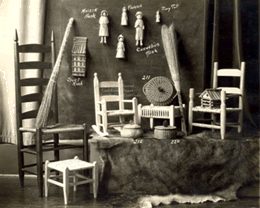The Crafts
Like a finely woven coverlet, multiple threads of thought and action made up the fabric of the Craft Revival. One focus of the Revival was preservation, the teaching and learning of skills thought to be endangered at the time. A 1925 brochure produced by the Crossnore School Weaving Department, north of Asheville, was typical in its proposal "to keep alive an almost forgotten art." Preservationist efforts focused on weaving, gathering community women to learn, produce, and sell hand woven articles. Spinning, dyeing with native plants, and weaving were among the skills taught at Craft Revival sites. While traditional skills were preserved, traditional forms were not. Craft Revival weavers did make traditional coverlets but, more often than not, weaving patterns were adapted to the production of smaller, non-traditional items, like table runners and placemats.
Similar to changes that affected weaving traditions, baskets and wood forms were adapted to Craft Revival markets. Baskets, long used as household containers, were made to sell to tourists during the Revival. In woodworking, the pocketknife, commonly used to pass the time whittling, was put to use making small, saleable figurative carvings. Larger, traditional forms continued to be made, including furniture (mainly chairs) and instruments (banjos, fiddles, and dulcimers). Pottery and blacksmithing forms were changed more by outside circumstances than by the Craft Revival itself. The introduction of glass jars reduced the demand for traditional pottery crocks. Likewise, the invention and popularization of the automobile meant that fewer blacksmiths were needed to outfit horses and wagons. Most natural native materials were put to use in craft production, including cornhusks. Cast off from shucking corn, this waste product was used to make cornhusk toys, hats, and purses.
See More: Read The Story of the Craft Revival and meet The People who participated as makers and promoters. Link to Resources, including a bibliography, lesson plans, and today's craft organizations.




